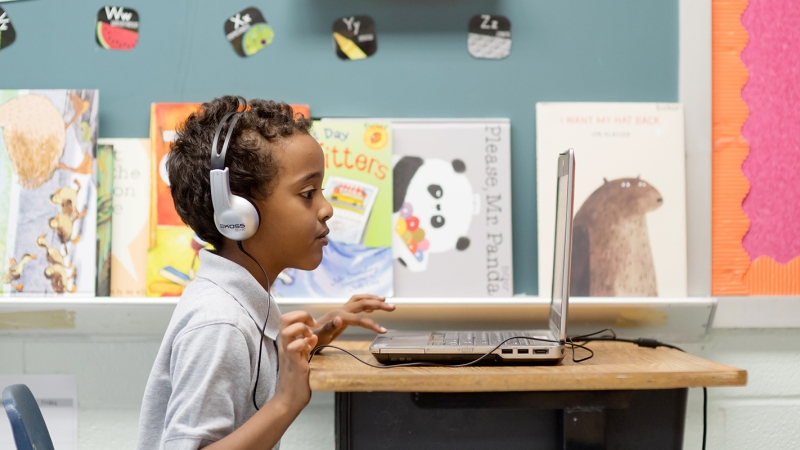
Augmentative and Alternative Communication (AAC)
A variety of techniques and tools to help individuals express thoughts, wants and needs, feelings, and ideas.
Augmentative and Alternative Communication (AAC) uses a variety of techniques and tools, including picture communication boards, line drawings, speech-generating devices (SGDs), tangible objects, manual signs, gestures, and finger spelling, to help the individual express thoughts, wants and needs, feelings, and ideas. (American Speech-Language Hearing Association, 2018)
AAC is augmentative when used to supplement existing speech, and alternative when used in place of speech that is absent or not functional. (American Speech-Language Hearing Association, 2018)
Learn how FCPS uses AAC devices to help give students a voice in their learning.
An AAC system is an integrated group of components used to enhance communication. These components include forms of AAC (aided or unaided), symbols, selection techniques, and strategies. (American Speech-Language Hearing Association, 2018)
The design of an AAC system incorporates each individual's strengths and needs. It incorporates the individual's full communication abilities and may include existing speech, vocalizations, gestures, languages spoken, and/or some form of external system (e.g., Speech generating device). (American Speech-Language Hearing Association, 2018)
An individual may use multiple modalities or many systems of AAC in combination, allowing for change based on context, audience, and communicative intent. A well-designed AAC system is flexible and adaptable. It allows for changes to vocabulary and mode of access as the individual's language and physical needs change over time. A well-designed system also maximizes the individual's abilities to communicate effectively and efficiently across environments and with a variety of communication partners (Beukelman & Mirenda, 2013). (American Speech-Language Hearing Association, 2018)
Core words are high frequency words that we use over and over again to communicate. For more information on core language, modeling strategies and ideas, check out this blog post from AssistiveWare on Teaching with Core Words: Building Blocks for Communication.
What is Modeling When Using an AAC Device?
Simply put, modeling is showing an AAC user where words are on an AAC device while providing verbal input (speaking key words and phrases). Check out some great tips on modeling with AAC from Praacticalaac.org.
Related Videos
Here are some short video examples of a communication partner modeling on an AAC device with an AAC user. Each video includes how to prepare for the activity.
Expanding on Your Child's Language When Using AAC
Children who are new to AAC may just use 1 or 2 words at a time while utilizing their device. We, as communication partners can expand or extend what could be said during a conversation.
Related Video
- PrAACtical AAC
Blog website providing AAC resources and implementation strategies, as well as weekly and monthly featured posts. To get started exploring activities and resources, type "core word of the week" or "literacy" in the "search this website..." dialog box. - AssistiveWare's Core Word Classroom 5 minute Fillers
Resource website with free printable core word displays, one page reference sheets, as well as AAC modeling suggestions for home and school. This website requires you to register with an email address to access their free resources. FCPS staff and student emails should not be used to register for an account. - AAC Language Lab Free Resources
Resource website with a variety of articles, activities, books, and games to help implement AAC. This website also includes free manual communication boards that can be downloaded and printed. No subscription is required to access the free resources.
Resources for Programming and Using AAC
- PRC Accent with NuVoice: General Operations and Settings
Video tutorial playlist on general operations and settings on Accent devices. - PRC Accent Programming Support
Video tutorial playlist on basic programming support for Accent devices. - PRC Accent with NuEye Eye Gaze Technology
Video tutorial playlist on device setup, positioning, calibration, and use of the NuEye Eye Tracking System. - PRC Accent with Look Eye Gaze Technology
Video tutorial on device setup, positioning, calibration, and use of the Look Eye Tracking System. - Saltillo NovaChat - General support website with video tutorials, recorded webinars, as well as implementation materials.
- Tobii Dynavox Indi with Snap Plus Core First
General support website with video tutorials to get you started with using Snap Core First. - Tobii Dynavox I-Series
General support website with video tutorials on device setup, calibration, and use of I-Series devices.
- Proloquo2Go
General support website with programming and troubleshooting information, as well as video tutorials. - Proloquo4Text
General support website with programming and troubleshooting information, as well as video tutorials. - LAMP Words for Life
Training and support website with general support information, programming tutorials, and recorded webinars. - TouchChat HD
Training and support website with general support information, programming tutorials, webinars, as well as implementation materials. - Verbally
General information website on the app for iOS and its features.





